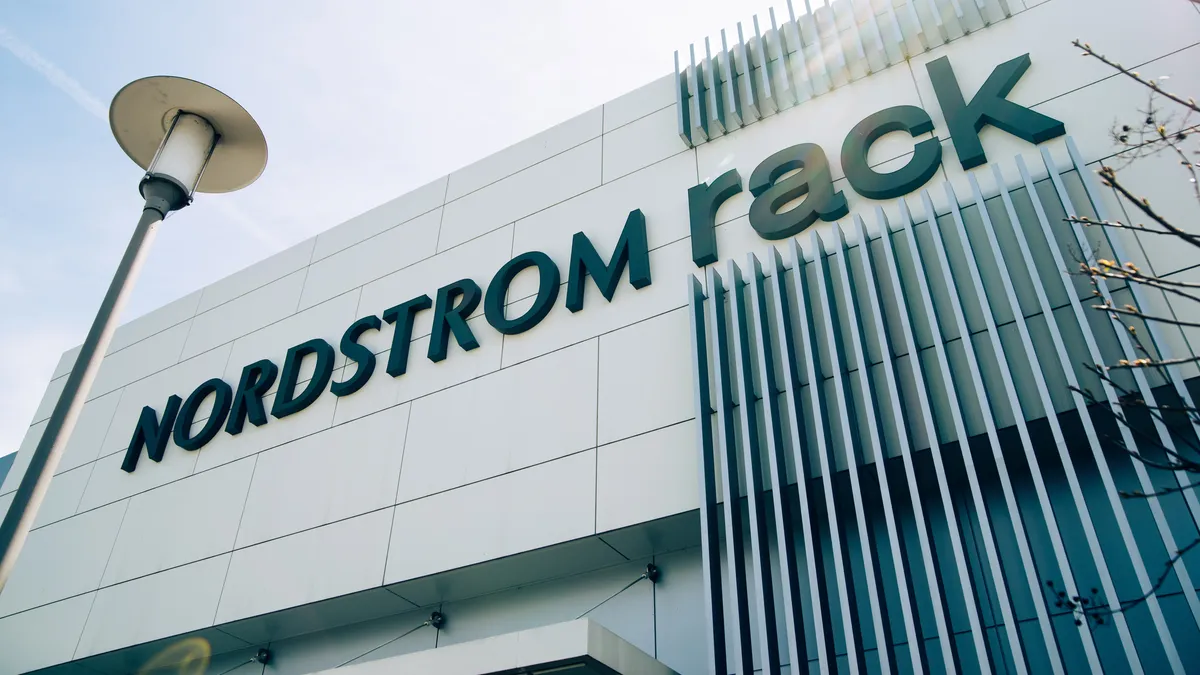Dive Brief:
-
Nordstrom beat expectations in the third quarter, reporting a 2.9% net sales decline to $3.4 billion, including a 300-basis point hit because its annual anniversary sale took place in the second quarter.
-
That timing shift, plus reducing Rack store fulfillment and sunsetting Trunk Club, dragged e-commerce down 1,000 basis points, falling 16.4% in the period to 34% of sales. By banner, full-line Nordstrom sales fell 3.4% to $2.3 billion, as off-price Rack fell 1.8% to $1.2 billion.
-
Ending inventory rose 0.6% this quarter, according to a company press release. Gross profit edged down to 33.2% from 35.1% a year ago, and the retailer swung to a $20 million loss from net income of $64 million last year.
Dive Insight:
A plethora of forces influenced the outcomes of Nordstrom’s Q3, including the timing of its big anniversary sale, the weather, the return of events and office work, a change in Rack’s online order fulfillment policy and the effect of inflation on higher-income versus lower-income customers, executives said Tuesday.
That is “leaving us to wonder how they view/project underlying trends,” BMO Capital Markets Managing Director Simeon Siegel said in emailed comments. “The company affirmed [fiscal year] guidance and expressed go-forward confidence, but we believe questions remain surrounding Rack performance.”
That’s particularly true given that off-price retailers like TJ Maxx and Ross performed well in the comparable period, several analysts noted.
Nordstrom kept a tight grip on inventory at a time when retailers are scrambling to unload merchandise, though it still has work to do at its Rack banner. The off-price business is in the midst of a pivot back to focusing on name brands, after last year’s disastrous, short-lived switch to a more value-oriented assortment. CEO Erik Nordstrom reiterated Tuesday that 90% of the top brands found at full-line Nordstrom are also sold at Nordstrom Rack. In Q3, sales of the top 100 brands at the Rack rose 9%, “which underscores the growth opportunity from increasing our supply of premium brands,” he said.
“With the work underway, we expect to optimize Rack product mix by mid-2023,” Erik Nordstrom told analysts. “We believe that improving our assortment and increasing penetration of top brands will differentiate the Rack experience for customers and drive profitable sales growth.”
The company also sees opportunity in growing Rack’s footprint. The stores are profitable, and brick and mortar, which fosters a treasure hunt, is especially important to off-price shoppers, Erik Nordstrom said.
He noted the growing fleets of rival off-price players, which he said have helped drive their growth. “And one of the things we know is, when we share a location, we share a parking lot with other off-price competitors in the vast, vast majority of cases, we have the highest sales per square foot," he said. "So when we share a parking lot, more often than not, customers choose us. So given our store count compared to what else is out there, some competitors, we think there’s a lot of attractive opportunities to add some stores.”
The danger is that Rack may also be successfully competing against the company’s own full-line stores, Siegel warned.
Siegel called Nordstrom's relatively slim inventory rise a "standout," but questioned what that means for each banner. “Unfortunately, we do not know the breakdown between Rack (in which having inventory would be a good thing) and Full Price (in which having too much is a liability), but the stark ‘cleanliness’ versus the broader excess inventory across the channel is noteworthy.”
Whatever forces buffet Nordstrom in the short term, some analysts see continued pressure on it in the long term. The department store won’t likely continue to gain market share as it once did, as shoppers gravitate to discounters for their core business and special occasion apparel, according to UBS analysts led by Jay Sole, who say they doubt the company can reverse its margin declines.
To fight back, Nordstrom must improve its loyalty program, merchandising and Rack’s digital marketing, see a bigger rebound in office wear and muster “surprisingly strong” sales at its New York City flagship, Sole also said.
The company may be moving into a new phase, which requires an expectations reset, according to William Blair analysts led by Dylan Carden.
“We believe that ultimately it makes more sense to run Nordstrom for profit versus growth, which could result in a more material decline in revenue in the medium to longer term,” Carden said.














